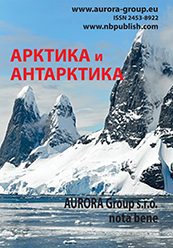Ground and Surface Waters of Cold Plains and Mountain Regions
Reference:
Pershin, D.K., Lubenets, L.F., Chernykh, D.V., Biryukov, R.Y., Zolotov, D.V. (2021). Open database of snow-measuring observations in the south of Western Siberia (2011-2021) and its comparison with data from stationary meteorological observations and satellite monitoring . Arctic and Antarctica, 3, 1–18. https://doi.org/10.7256/2453-8922.2021.3.36262
Abstract:
This article provides a database of the local snow-measuring observations for three river basins in the south of Western Siberia, reviews the methodological peculiarities of the conduct of measurements, and compares the acquired data with the observations at weather stations and available satellite data (CGLS SWE). Observations were carried out in several stages over the period of ten years (2011-2021) in small river basins of Kuchuk, Kasmala, and Mayma Rivers, and reflect the transition from the West Siberian Plain to the Altai lowlands. Total of 25,000 measurements of the parameters of snow deposits (snow mass and snow storage) were made over the years. The database of snow measuring observations is accessible to public. The comparison with station and satellite data indicated significant variances, but also fairly good coherence in some reservoir basins. According to satellite data, the common to basins mean squared error of snow storages was 42.9 mm, which is slightly higher than the claimed by the product engineers (37.4 mm). The time-limited observation data on the permanent routes of weather stations demonstrated the mean squared error of snow storages of 43.5 mm. In winter period, the mean squared error of satellite data gradually increased to the period of maximum accumulation of snow in reservoir basins. Moreover, the errors of satellite data did not depend on the snowiness of the winter period; and most likely, are associated with the parameters of microstructure of the snow mass in separate seasons.
Keywords:
Kasmala, Altai, database, snow density, snow surveys, snow depth, snow water equivalent, Mayma, Kuchuck, river basin
Permafrost and ground ice of the Arctic, Antarctic and mountain regions
Reference:
Budantseva, N.A., Vasil'chuk, Y.K. (2021). Ratio of isotopic parameters δ2H-δ18o in Late Pleistocene and Holocene ice wedge. Arctic and Antarctica, 3, 19–43. https://doi.org/10.7256/2453-8922.2021.3.36636
Abstract:
The subject of this research is the ratio of isotopic parameters of deuterium of heavy oxygen in ice wedges. The authors considered such parameter as inclination of the line of the ration of deuterium of heavy oxygen in ice wedges. Proximal to GMLV (or LLMV) position of isotope values for ice wedge and inclination of the line proximate to 8 suggests that the ice wedge was formed from atmospheric precipitation (winter snow). The article provides separate examples of anomalous deuterium ratios of heavy oxygen with very low ration of line inclination, which in combination with the abnormally low dexc values indicate the indicate isotopic fractionation processes in snow before melting and/or melting snow water before filling frost-cutting cracks. Three author determines the three main types of ratios of deuterium m of heavy oxygen content in ice wedge: a) normal ratio δ2H-δ18O (with line inclination of the ratio proximate to GLMV or LLMW). b) ratio of deuterium of heavy oxygen to deviation from GLMV or LLMW (with signs of change in the primary isotope signal of atmospheric precipitation), c) anomalous ratio of deuterium of heavy oxygen. It is shown that the first two types are characteristic to most ice wedge under study in the vast part of the Russian cryolithozone from the European North to the east of Chukotka; the third type is obtained for several Holocene ice wedge in Transbaikal and upper Yenisei River. This may be explained by significant isotope transformation of snow cover in the conditions of distinctly continental climate.
Keywords:
Chersky town, Yamal Peninsula, deuterium, oxygen isotope, permafrost, Holocene, Late Pleistocene, Ice wedge, Lower Kolyma River, Chukotka
Permafrost and ground ice of the Arctic, Antarctic and mountain regions
Reference:
Vasil'chuk, Y.K. (2021). Possible changes of the isotopic composition of ice wedge as a result of self-diffusion. Arctic and Antarctica, 3, 44–56. https://doi.org/10.7256/2453-8922.2021.3.36603
Abstract:
The subject of this research is the assessment of changes of the isotopic composition of ice wedge as a result of self-diffusion. The author offers a relatively simple method of considering the impact of the process of self-diffusion upon redistribution of paleo-isotopic composition that allows accurately and quickly estimating the changes in the values δ18О and δ2H values in ice wedges at different periods of the quaternary (1000 years, 10,000 years, 100,000 years, and 1,000,000 years). The patterns of diffusion process in physico-chemical systems are described by two differential forms of Fick's diffusion laws, which are transformed into Gaussian integral, using six-digit Chambers charts for calculation of the threshold values δ18О. The article applies the experimentally determined real values of self-diffusion coefficient in the ice – D=(2–10)×10-15 m2/s. The values of the Gaussian integral are calculated for time intervals, at different distances between samples with different concentration; for the period of 1,000 years its values in all cases exceed 0.99. For longer time intervals, these values change significantly. The calculated probabilistic values of changes in the concentration of heavy oxygen isotopes in ice wedge under the impact of self-diffusion at different distances and concentration gradients are noticeable only for the time period of over 100,000 years.
Keywords:
change of the isotopic abundance ratio, Gaussian integral, Fick's diffusion laws, self-diffusion, oxygen isotope, permafrost, Holocene, Late Pleistocene, Ice wedge, isotope concentration gradient
Permafrost and ground ice of the Arctic, Antarctic and mountain regions
Reference:
Khimenkov, A.N., Koshurnikov, A.V., Stanilovskaya, J.V. (2021). Parageneses of cryogenic formations of gas emission funnels (Part 2). Cryogenic factor in formation of gas funnels. Arctic and Antarctica, 3, 57–79. https://doi.org/10.7256/2453-8922.2021.3.35505
Abstract:
The subject of this research is frozen rocks that compose gas emission funnels in the north of Western Siberia. The object of this research is the cryogenic factor that causes the formation of gas emission funnels. The authors substantiate the thesis that gas emission funnels are cryogenic phenomenon, and the processes preparing the explosion cannot be accurately interpreted without taking these features into account. The analysis of research materials on gas emission funnels, discovered in the north of Western Siberia, allows concluding that surface conditions may have a significant impact upon the formation of gas emission funnels. Special attention is given to consideration of the hypothesis of formation of gas emission funnels due to local heat penetration and gas supply from the depth. The necessary conditions are described. The article provides the examples of using geophysical methods for detecting of gas supply channels. It is concluded that gas emission funnels are the result of self-development of fluid-dynamic geosystems, which represent local, ice subsurface gas-saturated formations that are in a inequilibrium thermodynamic state with respect to the enclosing permafrost formations. The authors' special contribution consists in examination of the external and hidden mechanisms of the emergence of inequilibrium conditions od the mechanism that launches an explosion. The novelty of this research lies in the development of technique for determining the processes that cause the emission of underground gas, based on the analysis of cryogenic formations, which compose the walls of gas emission funnels.
Keywords:
ice ground saturated geosystems, fluid geodynamics, gas fluids, gas filtration, dissociation of gas hydrates, heat flux, plastic deformations, permafrost, stage of development, paragenetic relationships
Soils of Cold Plains and Mountain Regions
Reference:
Vasil'chuk, Y.K., Vasil'chuk, J.Y., Ginzburg, A.P. (2021). Cryogenic soils in the Vilyuy River Valley (Yakutia). Arctic and Antarctica, 3, 80–107. https://doi.org/10.7256/2453-8922.2021.3.36671
Abstract:
The object of this research is the cryogenic soils of the territory located in Central Yakutia, in the middle reach of Vilyuy River nearby Makhatta Tukulan with middle-taiga larch woods landscapes. In July 2021, on the right and left banks of the Vilyuy River, twelve soil sections have been formed, which relate to turf-podzols and turf-sub-units of the illovial-ferruginous, sod and alluvial sod, psammozems and stratozems according to to classification and diagnostics of Russian soils (2004). On the slope of the river valley was also formed the soil catena that included elementary geochemical landscapes of river terraces tops and slopes surfaces, as well as middle and high floodplains on the slopes of thermofusional funnels. Soil sections were also formed in flooded beam bottom and well-drained ravine bottom, on sub-horizontal Makhatta Tukulan surface, bottoms and slopes of thermo-suffosional funnels. The study involves 46 soil samples for measuring the acidity level (pH), electric conductivity (EC), and concentration of total disolved solids (TDS). The explored soils are characterized with pH ranging from 2.81 to 7.78, with most common fluctuations of 5.5–5.6. TDS rates were often within the limit of 10 mg L-1 and rarely exceeded that threshold, however, there were single valyes higher than 50 mg L-1. Thus, the highest EC values (over 100 μS/cm) were measured in surface and subsurface horizons with high organic matter content, whereas mostly mineral horizons had typical EС values within the limit of 20 μS/cm.
Keywords:
dissolved and soluble salts concentrations, electric conductivity, acidity, soil-geochemical catena, elementary geochemical landscapes, Permafrost, soils, organic matter content, Vilyuy River, Yakutia
 This work is licensed under a Creative Commons Attribution-NonCommercial 4.0 International License.
This work is licensed under a Creative Commons Attribution-NonCommercial 4.0 International License.
 Eng
Eng













 © 1998 – 2025 Nota Bene. Publishing Technologies. NB-Media Ltd.
© 1998 – 2025 Nota Bene. Publishing Technologies. NB-Media Ltd.




